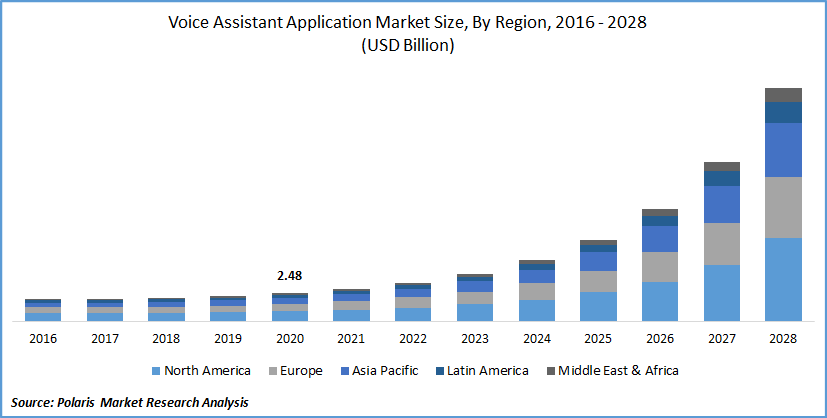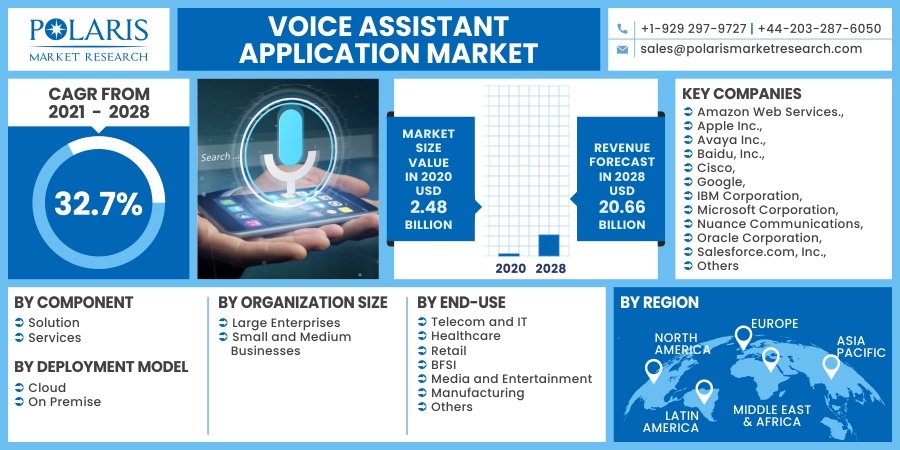
Voice Assistant Application Market Share, Size, Trends, Industry Analysis Report
By Component (Solution, Services); By Deployment Model (Cloud, On Premise); By Organization Size (Large Enterprises, Small and Medium Businesses); By End-Use (Telecom and IT, Healthcare, Retail, BFSI, Media and Entertainment, Manufacturing, Others); By Region; Segment Forecast, 2021 - 2028
- Published Date:Oct-2021
- Pages: 111
- Format: PDF
- Report ID: PM2114
- Base Year: 2020
- Historical Data: 2016 - 2019
Report Outlook
The global voice assistant application market size was valued at USD 2.48 billion in 2020 and is expected to grow at a CAGR of 32.7% during the forecast period. Voice assistant application is a digital assistant that follows voice commands to provide assistance with personal and business tasks. This application is based on technologies such as speech synthesis, voice recognition, and natural language processing to assist the user with various activities in homes, vehicles, educational institutes, healthcare facilities, and telecommunications environments.
 Know more about this report: request for sample pages
Know more about this report: request for sample pages
Some tasks performed by these assistant applications include making calls, setting timers, controlling smart devices, answering questions, reading news and information, and playing music, among others. This assistant application is integrated into mobile apps and operating systems to meet the changing user demands of speed, efficiency, and convenience in technology.
The increasing penetration of smart devices, growing digitization, and the need for improved customer experiences support the growth of this market. The adoption of smart homes and growth in the gaming industry over the years has encouraged businesses to offer improved platforms to users, increasing the adoption of voice assistant applications.
There has been an increase in the number of organizations adopting social media for marketing and catering to customers due to the profitability it provides to an organization. The rising adoption of the Internet of Things and connected devices has resulted in greater market demand for voice assistant applications. Technological advancements in AI, natural language processing, robotic assistance, and machine learning, reduced technology costs, and the ability to enhance existing business flow have further increased its adoption worldwide.
The integration of AI-powered in-vehicle voice assistants enhances the driver experience. Increasing market demand of smartphones and other mobile devices has increased the demand for apps and content, including familiar features and user interfaces. Delivery of high-quality entertainment, news, navigation, and driver assistance is done through voice assistant applications. Growing market demand for passenger vehicles, modernization of vehicles, and the increasing need to offer a luxury and comfortable driving experience have increased the incorporation of voice assistant applications in this sector.
The growing adoption of connected vehicles and the rise in the development of fully autonomous vehicles are expected to offer market growth opportunities in the automotive industry. Some early adopters of voice assistant applications for controlling vehicle infotainment systems include Honda, BMW, Mercedes-Benz, and Hyundai. Amazon launched its voice assistant application, Echo Auto, in 2018 in the United States. In the first half of 2020, Amazon launched Echo Auto in India, UK, Canada, Germany, Spain, and Italy to cater to users across the globe.
The adoption of voice assistant applications has increased during the pandemic due to users' greater need to optimize home, industrial, and office applications. There is a rising trend towards automated interactions and voice assistants as people are apprehensive of touching shared surfaces and being in shared spaces.

Know more about this report: request for sample pages
Greater concerns regarding health and safety have resulted in the development of voice-enabled machinery and kiosks for contactless interactions. Growing need for convenience, safety, and touchless interfaces has encouraged voice assistant applications in shopping and restaurants during the pandemic. With lockdowns and closures across the globe, several educational institutes have adopted these applications to improve functionality and communication with students.
IoT is increasingly being integrated into healthcare devices such as intelligent bedside devices for continuous monitoring of patients, increasing the adoption of these applications. Healthcare and government organizations are using voice assistant applications to assist the population with screening symptoms, delivering healthcare and precautionary information, and instructing them towards emergency services. These applications enhance safety and wellness for healthcare workers, patients, and hospitals.
Report Segmentation
The market is primarily segmented on the basis of component, deployment model, organization size, end-use, and region.
|
By Component |
By Deployment Model |
By Organization Size |
By End-Use |
By Region |
|
|
|
|
|
Know more about this report: request for sample pages
Insight by Component
The component segment has been divided into solutions and services. In 2020, the solution segment accounted for the highest market share owing to the increasing need for offering improved customer experience and adopting social media for marketing for customer interaction. Small and medium-sized businesses are increasingly investing in voice assistant applications for improved business processes and higher productivity.
Insight by Deployment Model
On the basis of deployment model, the market is segmented into cloud and on-premise. The market demand for cloud-based deployment is expected to increase during the forecast period owing to a significant increase in data generation and rising use of mobile devices and social media. Decreasing the cost of data storage coupled with the growing adoption of cloud computing accelerates the market growth of this segment.
Insight by Organization Size
The organization size segment has been divided into large enterprises and small and medium-sized businesses. In 2020, the large enterprise segment accounted for the highest market share due to the massive amount of data and resources and technological advancements. However, small and medium-sized businesses increase investment in voice assistants for efficiency, improved customer experience, and higher productivity.
Insight by End-Use
Based on end-use industry, the market is segmented into telecom and IT, healthcare, retail, BFSI, media and entertainment, manufacturing, others. The healthcare sector benefits greatly from voice assistants by delivering improved services to patients, offering remote therapy, facilitating doctor appointments through teleconferencing, observing patients remotely, and arranging clinical meetings, among others. A massive increase in the use of mobile devices and technological advancements support the market growth of this segment.
Geographic Overview
North America dominated the global voice assistant application market in 2020. Due to a significant increase in the need to enhance customer experience, businesses are increasingly turning towards voice assistant applications.
Established internet infrastructure in the region combined with the high adoption of advanced technologies fuels the growth of the market in the region. The increased penetration of smart devices, growing adoption of smart homes, and adoption of the Internet of Things and connected devices boost the voice assistant application market growth.
Competitive Landscape
The leading players in the voice assistant application market include Amazon Web Services., Apple Inc., Avaya Inc., Baidu, Inc., Cisco, Google, IBM Corporation, Microsoft Corporation, Nuance Communications, Oracle Corporation, Salesforce.com, Inc., Samsung, Google LLC, SAP, Verbio Technologies, Verint. These companies are taking initiatives to strengthen their market presence by introducing advanced solutions for their customers. These players are also collaborating with other market leaders to expand their offerings and acquire new customers.
Voice Assistant Application Market Report Scope
|
Report Attributes |
Details |
|
Market size value in 2020 |
USD 2.48 billion |
|
Revenue forecast in 2028 |
USD 20.66 billion |
|
CAGR |
32.7% from 2021 - 2028 |
|
Base year |
2020 |
|
Historical data |
2016 - 2019 |
|
Forecast period |
2021 - 2028 |
|
Quantitative units |
Revenue in USD million/billion and CAGR from 2021 to 2028 |
|
Segments covered |
By Component, By Deployment Model, By Organization Size, By End-Use, By Region |
|
Regional scope |
North America, Europe, Asia Pacific, Latin America, Middle East & Africa |
|
Key Companies |
Amazon Web Services., Apple Inc., Avaya Inc., Baidu, Inc., Cisco, Google, IBM Corporation, Microsoft Corporation, Nuance Communications, Oracle Corporation, Salesforce.com, Inc., Samsung, Google LLC, SAP, Verbio Technologies, Verint |
